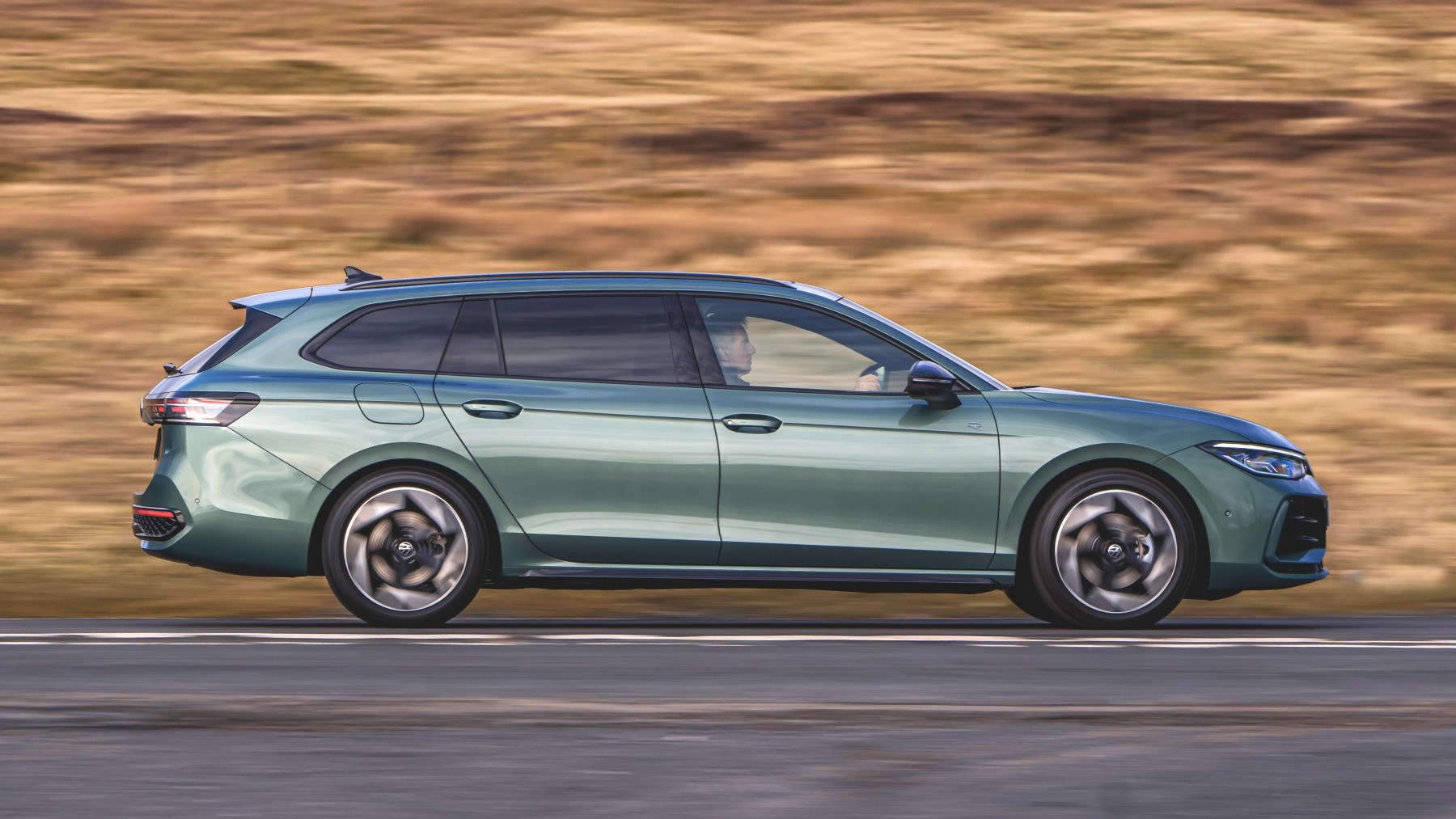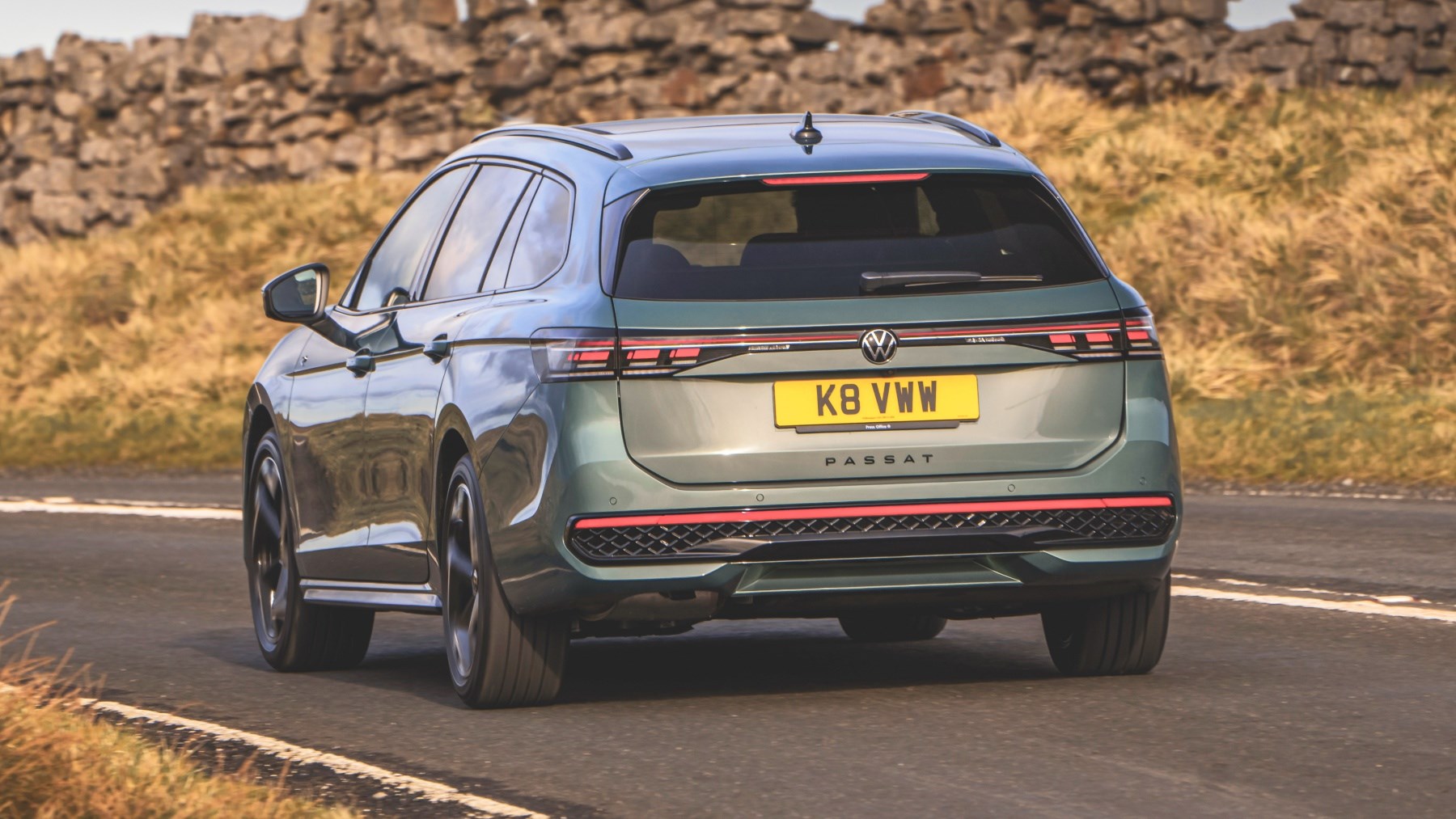► All-new Volkswagen Passat Estate driven
► Developed and built by Skoda
► Plug-in hybrid gets (much) longer range
We would call this the new Volkswagen Passat Estate, but really, it’s just the new Passat. While you’ve previously had a choice of posterior, the saloon has been axed due to slow sales in Europe. To help cut costs and let VW focus on the fully electric stuff, it’s actually Skoda that led development.
Not that we’re complaining. The Superb Estate is a fine family car and a bit of Volkswagen garnish is unlikely to change that, even if it’ll cost you about two grand to switch badges. With the ID.7 Tourer taking the lead on electric estates, the Passat remains powered by petrol or plug-in hybrid powertrains. Diesel? Perhaps unsurprisingly, no.
At a glance
Pros: Comfortable ride, spacious boot, much improved usability inside
Cons: 1.5 petrol a little weedy, no diesels, Superb a little cheaper

What’s new?
It’s an all-new design, and although it could be accused of being a thoroughly conservative effort, the new Passat’s sober suit goes with the territory. Don’t worry – it looks better than those timid original press shots had us believe. It’s no design masterpiece, and the ID-apeing front-end doesn’t quite gel with the sculpted flanks and rear. Fans of the old model’s chiselled looks will probably be quite disappointed.
But one can’t help but think that Volkswagen’s taking its latest Passat more seriously than previously thought, as it’s been changed quite considerably. After 34 million sales since the original B1’s launch in 1973, the Passat is still has some sway.
And that means it’s bigger, bolder and more electrified than before – and perfectly pitched for risk-averse buyers deferring their EV purchases for another few years.But we’ll skirt the issue of calling it all-new. Because it isn’t.

What are the specs?
The all-petrol line-up spans 148-268bhp, and it kicks off with the entry-level eTSI mild hybrid. The plug-in eHybrid model is the one that’s the most changed of the lot. Out goes the old 1.4-litre, to be replaced by the firm’s efficient 1.5-litre TSI Evo, and its battery pack has been substantially enlarged to give the PHEV a claimed range of more than 60 miles.
It’s available with 201 or 268bhp, and for those on the go, it supports CCS rapid charging. The eTSI is on sale now, with the eHybrid following later in 2024.
Other markets get the legendary 2.0 TDI, but UK customers are being politely steered towards the plug-in hybrid for the lowest potential fuelling costs. if you want a diesel VW family bus, buy a Tiguan.

How does it drive?
We’re going with the expected best-seller, the 1.5 eTSI. Despite having to shift more than 1500kg, it goes well enough if you give it plenty of revs. It can get a bit rowdy, and still delivers a meh 0-62mph time of 9.2-seconds.
On longer runs it plays to traditional Passat strengths by offering a smooth ride, hushed engine and low levels of wind and road noise. Expect economy well into the 40s, but some way shy of the 50mpg plus promised by official tests.
It’s biased towards relaxing, but not perfect by any means. There’s a little pitter-patter when presented with surface imperfections such as expansion joints or potholes, but not enough to affect this seriously polished performance. This is a car designed to spend its life on the motorway and it shows, especially with the DCC adaptive suspension fitted.

Leaving the motorway is a bit of a surprise, because it actually feels quite responsive. We won’t go as far as to call it fun, but the well-weighted, fluid steering, tight body control and strong brakes make this large estate much more agile than expected – and we’re happy that’s the case, as it shows the dynamic as well as practical advantages an estate has over rival SUVs.
So, it’s a predictable and highly polished product, just as you’d expect. There’s strength in depth here, and despite those evolutionary looks and drivetrains, it still manages to spring the odd surprise or two.
What about the interior?
Inside, it’s more of a leap forward, even if it’s not much of a surprise. It’s one of the firm’s first cars to feature new MIB4 infotainment system after the all-electric ID.7. Keen to cast aside its clunky, bug-ridden MIB3 software from the Golf Mk8 and ID.3, VW has worked hard to answer customers’ calls for simplicity.

Consequently, it feels like a Golf Mk8/ID.7 mash-up, is dominated by a 15.0-inch central touchscreen, and is peppered by touch-sensitive slider controls. As a final flourish it gets a dash-mounted ID-style drive selector, but it’s a shame VW didn’t take the opportunity to add the multi-function climate control knobs fitted to the Skoda Superb. Indeed, this is still a less-user friendly cabin than this car’s predecessor.
One can’t help but conclude that passengers get the best deal of all. In the rear, there’s excellent head and legroom – similarly-priced SUVs don’t even get a look in – and the load bay is enormous. Stick with the mild hybrid and you get a giant 690-litres of boot space, or 1920 with the rear seats folded. That’s more than even an E-Class Estate.

Naturally, the plug-in hybrids can’t quite match this. With a big battery beneath the boot floor seats-up capacity is 530 litres, still better than many more expensive estates that aren’t PHEVs.
Before you buy
There are three trims: Life, Elegance and R-Line. VW offers front- and 4Motion four-wheel drive, as well as two power variants of its eHybrid PHEV. The UK model line-up is offered with a blend of the 1.5-litre eTSI petrol (148bhp, front-wheel drive, seven-speed DSG auto) and the eHybrid models (201-268bhp).
VW is keen to promote those eHybrid PHEV models. Not least because, as well as using a new petrol engine as part of the mix, the battery size has grown by almost double (19.7kWh compared to 10.6kWh) and it offers a claimed 62 miles of e-range. That would make the Passat eHybrid one of the longest-range plug-in hybrids in terms of battery range.

Verdict
It doesn’t set the world alight, but the new Passat is comfortable, capable and quietly gets on with the job – as long as you don’t need a saloon or hatchback. It is outstandingly refined, has acres of room inside and is an excellent long-distance cruiser.
Is it the best estate car you can buy from around £40K? It’s up there, but the main potential sticking point will be the Skoda Superb, which is about to drop in and spoil VW’s party.
Specs for Volkswagen Passat 1.5 eTSI R Line